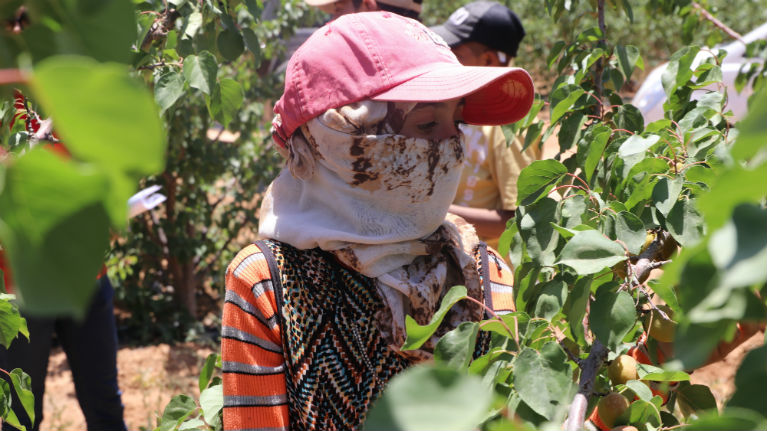Addressing the Worst Forms of Child Labour - The Jordanian Agriculture Sector
This project seeks to substantially reduce the incidence of the worst forms of child labour in the agriculture sector among host communities and Syrian refugees in Jordan.

Summary:
Between 2007 and 2016 the number of child labourers in Jordan more than doubled, from 29,225 to 69,661 according to the National Child Labour Survey (NCLS, 2016). The survey noted that 64 per cent of child labourers were engaged in work considered “hazardous” and 28 per cent were under the age of 14.The large inflow of Syrian refugees has impacted local economies and labour markets in Jordan, including an increase in the number of child labourers. Child labour is often employed as a coping mechanism to mitigate the dire economic situation in overstretched households. Syrian refugee children in Jordan often start working before the age of 12, becoming increasingly involved in occupations that are hazardous, involve long working hours and limit their right to an education.
This project works with various partners to tackle worst forms of child labour among Syrian refugees and host community members in Jordan’s agricultural sector. Partners include government representatives from the Ministry of Education and Labour, and those on the Child Labour Task Force (CLTF) under the Child Protection Working Group, as well as UN agencies, such as UNICEF, UNHCR, WFP and FAO and various NGOs. It focuses its interventions in four municipalities within the governorates of Mafraq, Irbid and the Jordan Valley, which host a large number of refugees.
Objectives:
Substantially reduce the incidence of the worst forms of child labour in agriculture among host communities and Syrian refugees in Jordan.- Improving the status of children vulnerable to child labour through referral to further education and protection services;
- enhancing the protection of working children above the minimum age for employment from occupational hazards in agriculture; and
- enhancing national and local knowledge and capacity to address child labour in agriculture.
Main Activities:
Ensure the referral system under the National Framework on Child Labour is functioning in the targeted municipalities; through:- Mapping services available to children in the four municipalities with a view to integrate them under the National Framework on Child Labour;
- sharing information with municipal and local service providers about the national referral system and facilitating initial dialogue toward its operationalization; and
- identifying and training focal points in labour inspectorates, teachers, agricultural cooperatives, employers and service agencies on the referral system.
- Conducting a rapid assessment to identify the current state of child labour in the four municipalities;
- conducting a tracer study to monitor the progress of vulnerable children and members of their families throughout the project cycle;
- organising a meeting between labour inspectorates, teachers, social workers, farmers, employers and other key stakeholders to establish a work plan to support the referral of children to available services; and
- developing, implementing and upgrading a systematic case management system among labour inspectorates, teachers, social workers, farmers, employers and other key stakeholders.
- Developing a cost-effective model for the four targeted municipalities to accelerate the gradual reinsertion of children in agricultural areas into education programmes;
- establishing mobile units for recreational activities and schooling for children who work with their parents in agricultural activities in the fields;
- using “Supporting Children through Education, Arts and the Media” (ILO SCREAM) to raise awareness on the dangers of child labour and to attract children back in a learning process; and
- launching a campaign allowing children to recount their experience and express their opinions regarding child labour in agriculture.
- Conducting awareness raising sessions with farmers and agricultural cooperatives in targeted communities;
- developing and sharing information packages about hazards for youth (16-18) in agriculture;
- assessing occupational health and safety risks on farms; and
- supplying youth (16-18) with necessary safety equipment to protect them from hazards.
- Enrolling family members of vulnerable children in vocational training, on-the-job trainings, and employment, including in Special Economic Zones (SEZs) and provide career guidance.
- Collecting data on child labour through monthly exercises at the municipal level; and
- launching a good practice database for the compilation of national and regional strategies to combat child labour.
Expected outcomes:
- A total of 1,000 children already engaged in and/or vulnerable to child labour have a more secure and improved status through referral to further education and protection services;
- a total of 3,000 working children above the minimum age are protected from occupational hazards in agriculture; and
- national and local capacity to address child labour in agriculture is enhanced.
Achievements to-date (October 2019):
- An assessment to identify and evaluate local services that are available to children under the age of 15 and those between the ages of 16-18, in the targeted governorates in Irbid, Ramtha, Zarqa, Mafraq and Northern Jordan Valley conducted, with a view to improve and unify their efforts to support children and their families. Local committees will be formed to discuss, recommend, coordinate the interventions needed to enhance the quality of the services being provided, with a separate assessment conducted in southern Jordan Valley.
- A survey to provide a better insight into the needs of vulnerable children and their families conducted. The survey, which was conducted in Irbid, Ramtha, Zarqa, Mafraq and Northern Jordan Valley, targeted 89 households including 152 working children.
- A baseline study to identify and assess the dimensions and drivers of child labour in agriculture conducted. The study involved over 2,000 survey respondents, including 1,544 children, 546 heads of households and 59 employers as well as key informant interviews and focus group discussions with stakeholders.
- At total of 400 at-risk and working children returned to school or started attending school for the first time